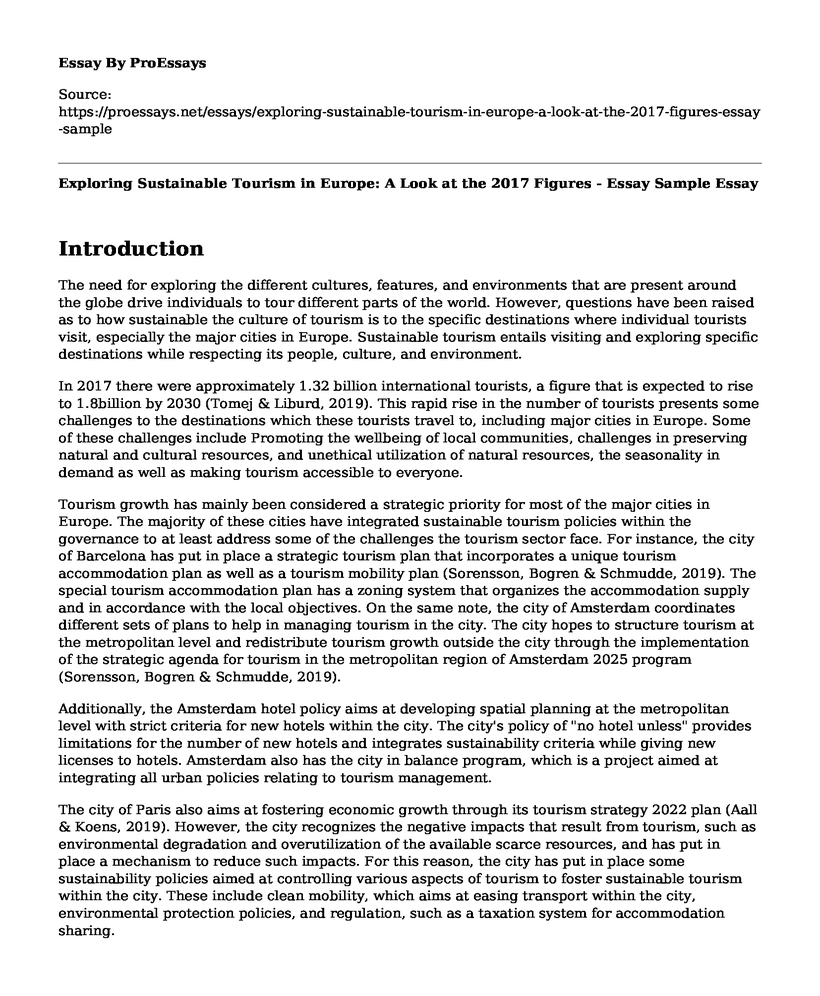Introduction
The need for exploring the different cultures, features, and environments that are present around the globe drive individuals to tour different parts of the world. However, questions have been raised as to how sustainable the culture of tourism is to the specific destinations where individual tourists visit, especially the major cities in Europe. Sustainable tourism entails visiting and exploring specific destinations while respecting its people, culture, and environment.
In 2017 there were approximately 1.32 billion international tourists, a figure that is expected to rise to 1.8billion by 2030 (Tomej & Liburd, 2019). This rapid rise in the number of tourists presents some challenges to the destinations which these tourists travel to, including major cities in Europe. Some of these challenges include Promoting the wellbeing of local communities, challenges in preserving natural and cultural resources, and unethical utilization of natural resources, the seasonality in demand as well as making tourism accessible to everyone.
Tourism growth has mainly been considered a strategic priority for most of the major cities in Europe. The majority of these cities have integrated sustainable tourism policies within the governance to at least address some of the challenges the tourism sector face. For instance, the city of Barcelona has put in place a strategic tourism plan that incorporates a unique tourism accommodation plan as well as a tourism mobility plan (Sorensson, Bogren & Schmudde, 2019). The special tourism accommodation plan has a zoning system that organizes the accommodation supply and in accordance with the local objectives. On the same note, the city of Amsterdam coordinates different sets of plans to help in managing tourism in the city. The city hopes to structure tourism at the metropolitan level and redistribute tourism growth outside the city through the implementation of the strategic agenda for tourism in the metropolitan region of Amsterdam 2025 program (Sorensson, Bogren & Schmudde, 2019).
Additionally, the Amsterdam hotel policy aims at developing spatial planning at the metropolitan level with strict criteria for new hotels within the city. The city's policy of "no hotel unless" provides limitations for the number of new hotels and integrates sustainability criteria while giving new licenses to hotels. Amsterdam also has the city in balance program, which is a project aimed at integrating all urban policies relating to tourism management.
The city of Paris also aims at fostering economic growth through its tourism strategy 2022 plan (Aall & Koens, 2019). However, the city recognizes the negative impacts that result from tourism, such as environmental degradation and overutilization of the available scarce resources, and has put in place a mechanism to reduce such impacts. For this reason, the city has put in place some sustainability policies aimed at controlling various aspects of tourism to foster sustainable tourism within the city. These include clean mobility, which aims at easing transport within the city, environmental protection policies, and regulation, such as a taxation system for accommodation sharing.
Achieving sustainable tourism can be quite challenging, and there is a need to involve all stakeholders in all stages of implementing sustainability programs. Stakeholders' participation at the planning stage makes them feel like they own the program, which motivates them to implement the plan effectively. Additionally, there is a need for cross-cutting coordination across all sectors within these cities to help in the planning and execution of the programs (Alfaro, Martinez & Jimenez, 2019). Lastly, individual cities should have in place a framework that allows for periodic sustainability assessment to gauge every progress.
References
Aall, C., & Koens, K. (2019). The discourse on sustainable urban tourism: The need for discussing more than overtourism. Sustainability, 11(15), 4228. doi:10.3390/su11154228
Alfaro Navarro, J., Andres Martinez, M., & Mondejar Jimenez, J. (2019). An approach to measuring sustainable tourism at the local level in Europe. Current Issues in Tourism, 1-15. doi:10.1080/13683500.2019.1579174
Sorensson, A., Bogren, M., & Schmudde, U. (2019). How do cities of different sizes in Europe work with sustainable development? International Journal of Design & Nature and Ecodynamics, 14(4), 287-298. doi:10.2495/dne-v14-n4-287-298
Tomej, K., & Liburd, J. J. (2019). Sustainable accessibility in rural destinations: a public transport network approach. Journal of Sustainable Tourism, 28(2), 222-239. doi:10.1080/09669582.2019.1607359
Cite this page
Exploring Sustainable Tourism in Europe: A Look at the 2017 Figures - Essay Sample. (2023, Mar 27). Retrieved from https://proessays.net/essays/exploring-sustainable-tourism-in-europe-a-look-at-the-2017-figures-essay-sample
If you are the original author of this essay and no longer wish to have it published on the ProEssays website, please click below to request its removal:
- Discussion and History of Tourism in Florida - Essay Example
- Destination Marketing Organizations Paper Example
- Essay on Cultural Heritage Shapes Our Lives: A 21-Year-Old African American Male's Story.
- Essay Sample on 7 Key Aspects of Cultural Diversity: Respecting Differences, Empowerment & Max Potential
- The Best Museum: A Website Survey for History Students - Essay Sample
- Essay Example on Superheroes: Increasing Diversity in the Modern World
- Comparison of Historical Events from Pre-Columbian Native American - Report Example







